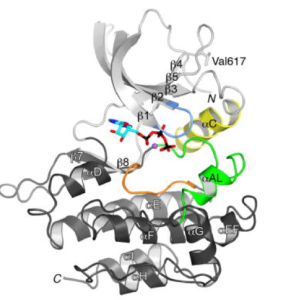A new perspective from outer space… and biospace.
The Ross Levine Lab continues to unravel the secrets of the JAK2 domain and working with Novartis may have hit the jackpot in CHZ868.
Behold, Pluto, lonely ice planet on the cusp of the Cosmos. Last stop in our solar system. This view and a glimpse of the deep Eternity beyond comes to us courtesy of Science. — and an historic scientific and engineering collaboration. The New Horizons space probe launched into space at 36,000 MPH on a nine year journey — reshaped our vision of reality..
A different nine year scientific journey approached its destination last year and promises to reshape a more immediate vision of our reality.
Tht voyage explored not the stars but probed dark and unknown events deep within the cell’s nucleus. Nine years after publication of his seminal paper on the JAK2 mutation in Cancer Cell— Memorial Sloan Kettering Cancer Center’s Dr. Ross Levine and his associates at Novartis reported on a close sighting built on the work of MPN scientists over the past decade.
The meticulous testing and exploration of processes through which the JAK2 mutation actually does its work — and sometimes resists inhibition that formerly worked — is not a dramatic space shot. It’s just the hard work of science that might help shut the door on JAK2-derived blood cell proliferation.
Levine and his associates presented a preliminary report at the ASH 2014 San Francisco meeting. It was noteworthy but a closer look was necessary to confirm pre-clinical findings. Now we have the record of his team’s deep journey into the infinity within, a journey into worlds where 100 million and more protein factories fit on the period at the end of this sentence.

Crystal structure JAK2/JH2 Nat Struct Mol Bio The Activation Loop is colored Red.
Published online 2012 Jul 22. doi: 10.1038/nsmb.2348
The peer-reviewed published paper on genetic and functional studies of CHZ868, appearing in Cancer Cell, is only the current stop in Levine’s quest to unravel the root of myeloproliferation. Five years ago his study of the JAK2 gene’s resistance to ruxolitinib (Secrets of JAK Inhibition) unravelled the mystery of why Jakafi, in many cases, would stop being effective in reducing swollen spleens and other myelofibrosis symptoms.
Here, with his team from Memorial Sloan Kettering Cancer Center and Novartis, he takes the work a giant step forward into the structural biological domain of the Janus kinase itself and its twin star configuration joined by an activating loop.
By stabilizing the inactive state (Type II inhibition) versus the active, cytokine signaling state as other Type I JAK inhibitors do, CHZ868 durably relieves major MPN symptoms. Working with human MPN cells and in vitro mouse models, CHZ868 reduces the allele burden, restores apoptosis and rolls back fibrosis of the marrow capsule. Along the way this approach may have solved the problem of the JAK2 adaptive resistance to inhibition, something Ross Levine has called persistence.
It’s not the shattering image of Pluto and its moons but this closeup view of the active and inactive conformations of JAK2 kinase and its linked pseudokinase stands a much better chance of ultimately returning something of immediate and lasting value to the human race. (The complete interview with Dr. Levine will appear in the September issue of the MPN Quarterly Journal.)
“JAK2 V617F represented a key finding at a critical time that helped to usher in the modern era of precision medicine. We now take for granted that molecular genetic studies can be used to diagnose cancer patients, to risk stratify patients into different subsets, and to guide the development and use of molecularly targeted therapies in the clinic. The identification of JAK2 V617F provided the impetus for the next decade of genomic insights in nearly all human malignancies. We are at a different place now because of this discovery; it has changed the lives of scientists, physicians, and most importantly, patients, in countless ways.” – Ross Levime, MD and Gary Gilliland, MD, PhD, in The Hematologist
© 2015, MPNforum, LLC. All rights reserved under Creative Commons Attribution-NonCommercial-NoDerivs 3.0 Unported License.



Leave a comment